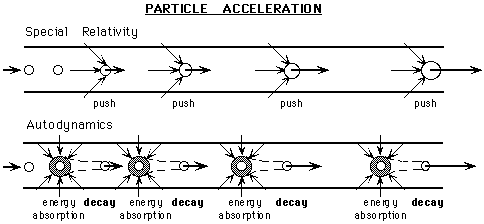Decay / Energy / Absorption
To put it most succinctly: AD describes the fundamental mechanisms of the universe as decay and its opposite, energy absorption. One of the great legacies and mysteries of SR is the equation:
E = mo c^2
Einstein gave us energy mass equivalence. What he did not give us was examples of how one changes into the other.
A natural thought experiment every physicist and engineer goes through when they are first introduced to energy mass equivalence is to try and find examples. It is easier to think of ways in which mass changes into energy: decay. It is more difficult if not impossible to think of the opposite: energy absorption. One thought that comes to mind are nuclear reactions in a sun where atoms are constructed. But this is not pure energy changing into mass.
AD does not explain WHY decay and energy absorption occur: it liberates them. Einstein gave us energy mass equivalence but not the power to use it. If you look closely at SR, it treats all energy transfers as external phenomena. Particles are billiard balls that bash into each other and break into pieces. This has been the perception of modern physics since the advent of powerful particle accelerators. Scientists smash matter into smaller and smaller pieces trying to find the most fundamental “unifying” particle of the universe.
But what if we were to look at the world differently. What if instead of particles being like billiard balls, they were more “plastic”. Particles would join and break apart not always as separate entities but actually “meld” together in some intermediate form.
One clear example of the difference is comparing the particle acceleration model in SR and AD. In SR, energy is transferred to the particle externally: it is pushed on its way. In AD, the particle absorbs energy and then decays, propelling it on its way.

Another clear example of the difference between SR and AD is the
Compton Effect
. In the Compton Effect, a photon (most commonly described from an X-Ray source) collides with an electron, loses energy which is transferred to an electron in the form of KE. This process, like all processes in SR, describes energy transfer as a kinetic phenomena. In AD, things are quite different. In the Compton Effect, the photon collides with the electron and is absorbed, forming some intermediate particle. Given that energy tends towards the most stable state (QM), the new unstable particle breaks apart or decays into an electron and a photon of a smaller frequency and energy.
The result of looking at the Compton Effect as decay and energy absorption is a more accurate Compton Effect equation. Physicists who have seen the new equation have found it much more precise and complete.